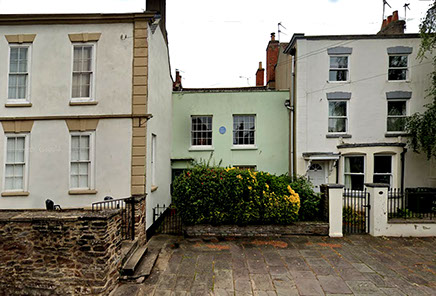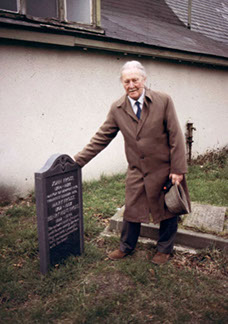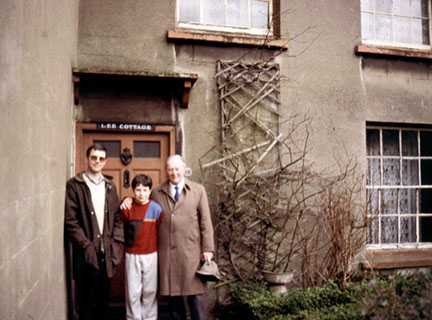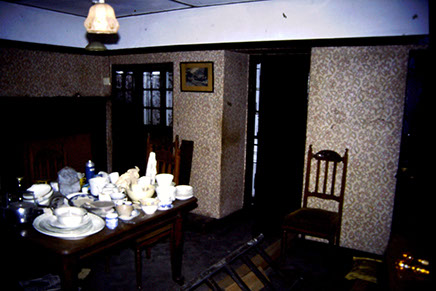
Frost's House, Bristol
 JOHN FROST’S HOUSE at 68 Park Road, Stapleton, Bristol (Photo: Sylvia Mason)
JOHN FROST’S HOUSE at 68 Park Road, Stapleton, Bristol (Photo: Sylvia Mason)
Always a regular visitor to Newport Museum and Art gallery, Richard Frame remembers pausing at the cabinet, housing the Chartist collection, which in the 1980s included an old photograph of John Frost’s house.
It was at Stapleton that John Frost rejoined Mary, his wife on his return in 1856 from exile. They had not seen each other for over 16 years. Not since, she visited him in Monmouth gaol in December 1839, just before his trial in January 1840, which was followed by his removal in February to Portsmouth and his swift dispatch, with Zephaniah Williams and William Jones, on the Mandarin sailing ship to Van Diemens Land (Tasmania).
By July that summer, William Foster Geach, Mary’s son, from her first marriage, had placed the family property at High Street on the market. Chartist friends assisted Mary’s daughters to find fashionable accommodation and fit into the radical scene of Montpelier, Bristol, where Mary continued living until at least mid-1845. The 1851 census shows that she had by then moved to the Stapleton district.
Richard Frame’s interest in the whereabouts of the house, came about through his determination to find John Frost’s burial place.
“I moved in 1983 to live on the Bassaleg Road and soon became interested in locating those people buried in the neighbouring Cemetery who had played a role in the development of the town. It wasn’t just those who had grand memorials to keep their names alive. I was equally interested in the dips in the ground of those unknown souls who played their part as well. This meant long periods thumbing through old newspapers in Newport Reference Library and seeking out their stories.
It occurred to me that I didn’t know where John Frost was buried. Was his body brought back to Newport after his death in 1877 or was it put to rest near Bristol? It soon became apparent that no one had any idea where his body lay.
Together with a friend, Derek Priest, I made a visit to Stapleton and searched around local burial grounds, but that came to nothing. Bristol’s Reference Library provided no clues and a visit to Canford Cemetery in Bristol, where they held the records of all those buried in public cemeteries, revealed nothing. "
The answer was eventually uncovered in Newport’s Reference Library.”
Richard was shown a booklet produced for the centenary of the Chartists by Newport’s chief librarian and the Museum’s curator, listing the Chartist documents and ‘relics’ in their collections:
J. Warner & W.A Gunn, John Frost and the Chartist Movement in Monmouthshire;. Catalogue of Chartist Literature, Prints and Relics Etc, Newport Chartist Centenary Committee , 1939
And he spotted that the third item on its first page is a copy of Frost’s will, dated 12th June 1874 and proved at Bristol 9th January 1878.
Reading the Library’s document copy, Richard found the vital clue - ‘I desire that my funeral be a public one and that I be buried by the side of my wife and son in Horfield Churchyard’.
With the location of John Frost’s grave established, Richard remembered “the photo in Newport Museum! and wondered if the house was still there”. This was the age without the Sat Nav, Google Maps and internet data – everything depended upon fieldwork. And without an address, he was looking for ‘a needle in a haystack’.
Searching around the district of Horfield church, turned out to be the wrong place. Anyway, his time was taken up with getting a new gravestone made and arranging the unveiling ceremony in 1986. Although interested, nobody at Horfield, could help with his enquiries.
Richard was in touch with Alexander Cordell, the author of ‘Rape of the Fair Country’; the book that had sparked his own original interest in the Chartists. And in 1986, Newport Local History Society (of which Richard was secretary) published a Newsletter to which Cordell contributed a feature entitled ‘The Making of a Chartist’. In his article, Cordell discussed the influences that shaped the man who was to become one of the most important Chartist leaders.

Living in the Isle of Man, Cordell was unable to attend the unveiling ceremony, but he was, says Richard “determined that on his next visit to Wales we would take a trip to Horfield."
"On Saturday 14 March 1987, David Illife, Alexander Cordell and myself visited Frost’s grave and from there we made the short journey to Stapleton, where we felt fairly confident we would find the cottage. But despite having a copy of the photograph from Newport Museum, we drew a blank.
On the verge of giving up for the day, we passed a cottage that looked vaguely like the one we sought, but it was set back well off the road.
We took a chance and knocked on the door. Luckily, somebody was in. Mrs Packwood, the occupant, was fascinated by the story but was unable to help us. We were about to leave empty-handed when a young voice chirped up from the back of the house:
‘I know where it is mum’, called young James.
It turned out that, by a remarkable chance, only weeks before he had been to visit Newport Museum and seen the photograph in the display cabinet and recognised it immediately. Just a short distance from their home, we found Lee Cottage. The outside hadn’t altered a bit since that early photograph. It appeared unoccupied and in a poor state of repair ”

So, this was where Frost had lived until his death on 27th July 1877 in his ninety third year. Mary had died in 1857, within a year of his return from Tasmania. Catherine, his eldest daughter, who had gone out to Australia in 1853 and brought him home in July 1856, via New York, returned to Australia in 1858. Frost continued living here with his youngest daughter, Anne, whom he is said to have described ‘as the solace of his declining years’.
“Peeping through the window it was clear that no one had lived there for many years. It was quickly established that the house had recently been bought by a local councillor, who lived next door and was planning to refurbish it, so that he could move his mother in.

Inside the house in 1987
A visit was arranged and Les James, David Osmond and myself met up with the new owner and entered what seemed like a time capsule. The inside of the house appeared as if Frost had just popped out. Even the garden, in its overgrown state, added to the atmosphere.
.jpg?crc=4052580420)
(Photo: Sylvia Mason)
The owner’s mother had died before work could begin and the cottage was sold. Returning a few years later it was good to see that a sympathetic restoration had been carried out and a blue plaque had been erected to mark the home of the Chartist leader.”





“Sailing Directions for the Bristol Channel” compiled by E J Bedford 1884 (British Library)




